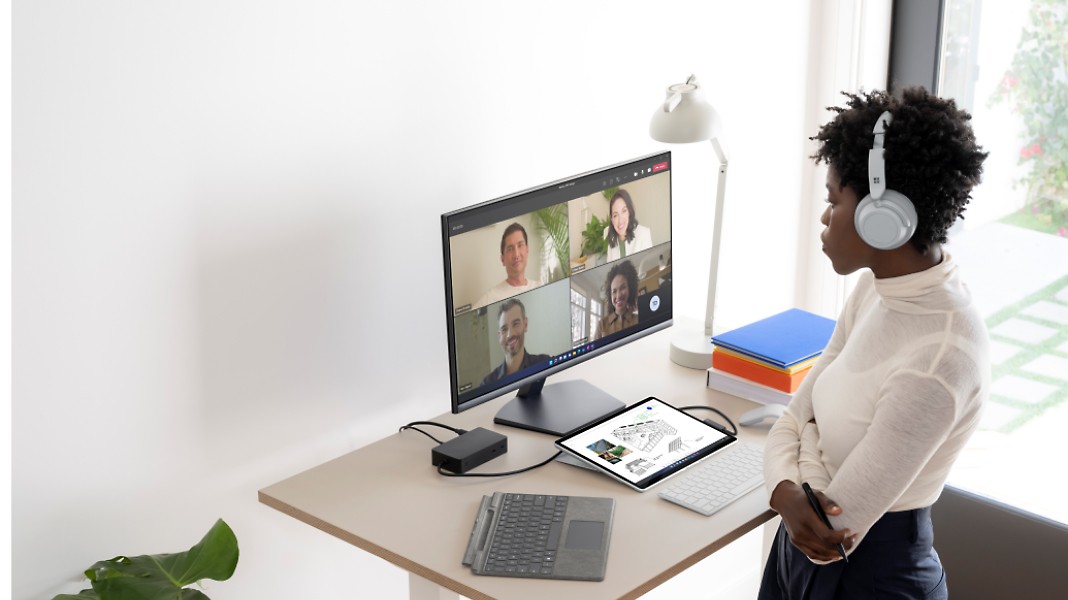Use AI to help employees focus and innovate.
What is hybrid work?
Increase employee productivity and morale with hybrid work.
Get the best of both worlds with hybrid work and Microsoft Teams
Take your productivity to the next level, no matter where you’re working.
Stay connected
Keep up to date with your projects and team using collaboration tools such as chat, calls, and meetings.
Reduce meeting fatigue
Collaborate in new ways and have more natural meeting experiences using the features in Teams.
Work across devices
Experience easy transitions across devices at home, on the go, or in the workplace.
A work life that’s as flexible as you are
Check out some of the features and benefits of hybrid work.
-
Hybrid work definition
Hybrid work describes when people work together, both online and in person, at any time from anywhere—at home, remotely, or from an office.
Back to tabsGet caught up
Meeting recap is a multi-feature, cross-product experience to help Microsoft 365 users get the most out of their hybrid meetings.
-
Customize your hybrid work approach
Learn about the different hybrid work models and which may work best for your organization.
You set your own hybrid work schedule
The flexible model allows you to combine remote and in-person days however works best for you.
Your organization sets your hybrid work schedule
In this model, your organization chooses the days that you work remotely and in person.
In-person work is prioritized
In an office-first approach, you’ll spend most days in the office with the flexibility to work from home occasionally.
Back to tabsRemote work is prioritized
The remote-first model focuses on remote work as the standard, with the option to come in person for collaboration and meetings when necessary.
-
Solve common problems
Learn what both employees and organizations can gain from hybrid work models.
Improve employee happiness
Boost morale by offering the flexibility to work from home when needed—whether it’s to save on commute time, organize childcare, or have a quieter workspace.
Recruit and retain top talent
Employee expectations have changed, with many people wanting their next job to offer a combination of in-person and remote work.
Back to tabsReduce your building footprint
Large offices are expensive to rent and maintain. With fewer employees in the building, many organizations can downsize and cut costs dramatically.
-
How remote and hybrid work differ
Remote work takes place completely offsite, while hybrid work uses a mix of onsite and offsite workspaces.
Read more about remote and hybrid work
Designing the new hybrid meeting experience—for everyone
Brace yourselves: Hybrid work is hard
Using research to unlock the potential of hybrid work
Creating an effective work from home setup

What is hybrid work?
Hybrid work is a combination of traditional, in-person office work and remote, offsite work. This mix of work locations allows employees to enjoy greater flexibility in their lives. For example, on one day, an employee may choose to work from home because they know they’ll be most productive in a quiet atmosphere, while the next day, they may choose to come to work in person to attend an important meeting.
As organizations increasingly adopt hybrid work models, some are also implementing hot desking. Hot desking refers to reserving flexible workspaces in an office that aren’t assigned to a specific employee. These spaces act as a strong solution for hybrid work by giving people a physical place to sit when they visit the office, rather than a dedicated personal desk—which takes up space and goes unused when people are working remotely.

Hybrid work in the pandemic
Even though hybrid work existed before COVID-19, the pandemic gave organizations an urgent reason to switch to it. Since then, hybrid work has become more popular than ever, with some organizations moving permanently to fully remote or hybrid models and downgrading their physical offices. And these changes aren’t vanishing anytime soon. Based on the 2022 Work Trend Index (WTI) report, 51 percent of current hybrid employees say they’re likely to go remote in the year ahead—a clear sign that remote and hybrid work are here to stay, even as global health concerns lessen.
Hybrid work models
One of the strengths of hybrid work is its flexibility. Organizations and employees can choose the model that makes the most sense for them and their business and personal needs. Here are a few common types of hybrid work models.
Flexible
A flexible hybrid work model gives employees the most freedom—they can set their own schedules with a combination of in-person and remote days that work best for them. In this model, an employee may stick to the same schedule every week or switch it up as they prefer. One downside to this approach is that the lack of consistency may make certain gatherings or meetings among coworkers more difficult to plan.
Fixed
The fixed hybrid work model has more restrictions. In this model, an organization sets the remote and in-person schedules for its hybrid employees. Typically, fixed schedules remain the same each week and may take an office-first or remote-first approach. The consistency of the fixed model is helpful for knowing the best ways to get in touch with coworkers, although some may find it inflexible.
Office first
An office-first approach prioritizes in-person work over remote work. Accordingly, employees under this model spend the majority of their work days in the office, with some days spent working remotely. Teams that need to frequently collaborate in person tend to prefer this model.
Remote first
Conversely, a remote-first model prioritizes remote work over in-person work. In this approach, in-person work may be limited to a day or two per week or month. This model has the greatest potential for savings in terms of downsizing office space, but it comes with the least in-person interaction with coworkers.
Hybrid work benefits
Beyond helping keep people employed and healthy during a worldwide pandemic, hybrid work offers numerous benefits—which is why it’s unlikely to go away anytime soon.
Healthy work-life balance
For many, the pandemic put a lot of priorities into perspective about what people want out of work and life. More than half of employees now say they’re more likely to prioritize health and wellbeing over work than before the pandemic (2022 WTI). Some work-life balance pros of hybrid work include:
- Less frequent commuting.
- Greater flexibility to arrange personal appointments, such as childcare and doctor visits.
- The ability to relocate.
The opportunity to relocate is a particularly radical change compared to the past, when people were tethered to cities where they could find the best jobs for their industries. With the newfound freedom of hybrid work, people can move closer to family or the city they always dreamed of without sacrificing career goals.
Competitive edge
Because of how workers’ expectations have changed, the organizations that will remain the most competitive are those that respect and cater to those expectations. In 2020 alone, 17 percent of people left their jobs. This trend continued in 2021, with 18 percent of people leaving jobs (2022 WTI). The top two reasons people cited for leaving were personal wellbeing/mental health and work-life balance. And with 51 percent of hybrid employees saying they’re likely to go fully remote in the next year (2022 WTI), the people have spoken—they want remote and hybrid options to stay, and they’re unwilling to tolerate unhealthy work conditions that were previously seen as status quo.
Naturally, employers that meet these needs by offering hybrid and remote options will be able to recruit top talent in ways that less flexible employers won’t. Recruiters with hybrid policies can also cast a wider net for the positions they’re filling when not limited to a geographic location, enabling them to find the best candidates for their organization.
Cost savings
When an organization makes the switch to hybrid work, it can reduce the number of permanent desks and its overall building footprint. For large organizations in pricey markets, this could mean a huge cost savings on rent and building upkeep.
See hybrid work solutions in action
Explore the ways that organizations are already changing to embrace hybrid work.
Increase productivity and innovation with help from AI
Use AI to help people save time, focus, and be more creative as the pace of work intensifies.

L’Oréal gives hybrid work a makeover with Microsoft 365 and Microsoft Teams
“In this new world, L’Oréal is focused on facilitating collaboration, communication, and co-creation among our employees, which is why we use Microsoft 365 and Microsoft Teams.”
Etienne Bertin: Chief Information Officer, L’Oréal

Resources to help you thrive in a hybrid work world

Use AI to help employees focus and be more efficient
Over the past three years, the pace of work has increased substantially, making meaningful work nearly impossible. AI can help people redirect their time and energy toward important creative work that drives productivity gains and innovation.

You’re probably already doing hybrid work
Learn from the millions of people working in hybrid models with the latest hybrid workplace research, including seven trends that will shape the future, the role managers play in keeping teams connected, and six principles for wellbeing.

The future looks hybrid
Hybrid work models empower people to work differently. Discover the latest thinking about the hybrid workplace, enabling hybrid work with collaborative apps, and how to equip everyone with the right devices and accessories for hybrid work.
Do more with less using Teams Phone
Stay on budget while reducing the number of apps you use to get work done.
Significant savings
A recent study found a 143 percent return on investment1 when switching to Teams Phone.
Simplified IT management
Free up your IT admins’ time with a single app that’s easy to deploy and manage.
Reliable communication
Experience enhanced call reliability with features such as bandwidth controls and noise suppression.
The forefront of innovation
Stay productive and connected wherever you work with hundreds of innovative new capabilities and devices.
Frequently asked questions
-
A hybrid work schedule refers to the days and times someone spends working in person and remotely.
-
A hybrid work environment describes any location that an employee is working from while collaborating with others who may or may not be physically present—this could be in person at a physical office, remotely from home, or remotely in a coworking space (to name just a few).
-
Some challenges associated with hybrid work include:
- Leadership that doesn’t allow all employees to equally participate in hybrid work.
- Employees who have a strong preference for one side of hybrid work—for example, they prefer to work fully in person or fully remote and are resistant to change.
- Security vulnerabilities that can arise when employees are working remotely on personal networks.
- Significant time zone differences between an organization’s headquarters and where an employee is working remotely.
Fortunately, when organizations anticipate potential obstacles from the start, they can make plans to proactively prevent many issues.
-
To have a successful hybrid work environment, organizations should:
- Ensure that leadership is onboard and supportive with the chosen hybrid work plan and policies.
- Select a hybrid work model and clearly communicate what it means for employees.
- Consider which technology could complement the hybrid work—for example, will your organization change some permanent desks to hot desks and implement Teams displays?
- Consistently poll employees to learn what’s working and what could use improvement.
Get started with Microsoft Teams today
-
Home
-
Business
-
Enterprise
-
Education

















Follow Microsoft Teams